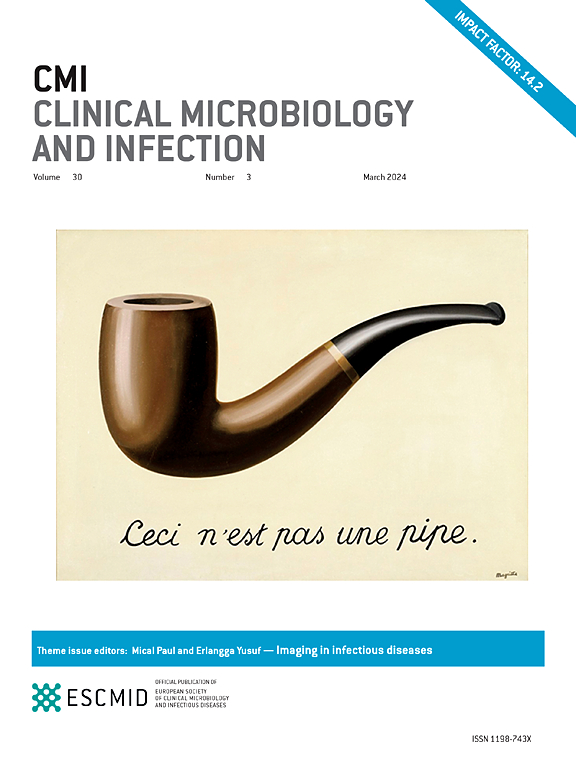Diagnosing infectious encephalitis: a narrative review
IF 10.9
1区 医学
Q1 INFECTIOUS DISEASES
引用次数: 0
Abstract
Background
Diagnosing infectious encephalitis can be challenging as it can be caused by a wide range of pathogens, with viruses being the most common cause. In a substantial number of patients, no pathogen is identified despite a clinical diagnosis of infectious encephalitis. Recent advancements in diagnostic testing have introduced new methods to address this diagnostic challenge and improve pathogen detection.
Objectives
The objective of this study is to provide a comprehensive clinical approach for diagnosing infectious encephalitis and explore novel diagnostic methods.
Sources
We searched PubMed to identify relevant literature on diagnosing encephalitis in English up to 1 September 2024, as well as included articles known by the authors.
Content
Clinical characteristics may suggest a specific cause of infectious encephalitis, but are insufficient to guide treatment decisions. Therefore, cerebrospinal fluid (CSF) examination remains the cornerstone of the diagnostic process, with CSF leucocyte count being the most reliable predictor for central nervous system infections. CSF features can be normal, however, in a proportion of patients presenting with infectious encephalitis. A definite diagnosis of infectious encephalitis is established by microbiological or histopathological tests in ∼50% of patients. Additional investigations, including neuroimaging or electroencephalography, can provide evidence for encephalitis or help to identify alternate conditions, although their role is primarily supportive. Emerging diagnostic techniques, including next-generation sequencing metagenomics and unbiased serology (Phage ImmunoPrecipitation Sequencing), have the potential to increase the proportion of patients with a confirmed diagnosis. However, these techniques are not yet practical because of their complex analysis, long turnaround times and high costs.
Implications
Microbiological confirmation is paramount in the diagnosis of infectious encephalitis, but it is currently established in about half of cases. Although novel techniques show promise to increase the proportion of cause-specific diagnoses, they are not yet suitable for routine use. This highlights the ongoing need for advancements in diagnostic methods.
诊断传染性脑炎:叙述性综述。
背景:传染性脑炎可由多种病原体引起,其中病毒是最常见的病原体,因此诊断传染性脑炎具有挑战性。在相当多的患者中,尽管临床诊断为传染性脑炎,但却无法确定病原体。诊断检测的最新进展引入了新的方法来应对这一诊断挑战,并改善病原体检测:提供诊断传染性脑炎的综合临床方法,并探索新型诊断方法:我们检索了PubMed,以确定截至2024年9月1日有关诊断脑炎的相关英文文献,以及作者已知的收录文章:临床特征可提示感染性脑炎的具体病因,但不足以指导治疗决策。因此,脑脊液(CSF)检查仍是诊断过程的基石,而脑脊液白细胞计数是预测中枢神经系统(CNS)感染最可靠的指标。然而,一部分感染性脑炎患者的脑脊液特征可能是正常的。约 50%的患者可通过微生物学或组织病理学检查确诊为传染性脑炎。包括神经影像学或脑电图在内的其他检查可提供脑炎的证据或帮助确定其他病症,但其作用主要是辅助诊断。包括新一代测序元基因组学和无偏血清学(PhipSeq)在内的新兴诊断技术有可能提高确诊患者的比例。然而,由于分析复杂、周转时间长、成本高,这些技术尚不实用:微生物学确诊在传染性脑炎的诊断中至关重要,但目前只有约一半的病例可以确诊。虽然新型技术有望提高病因确诊的比例,但还不适合常规使用。这凸显了诊断方法不断进步的必要性。
本文章由计算机程序翻译,如有差异,请以英文原文为准。
求助全文
约1分钟内获得全文
求助全文
来源期刊
CiteScore
25.30
自引率
2.10%
发文量
441
审稿时长
2-4 weeks
期刊介绍:
Clinical Microbiology and Infection (CMI) is a monthly journal published by the European Society of Clinical Microbiology and Infectious Diseases. It focuses on peer-reviewed papers covering basic and applied research in microbiology, infectious diseases, virology, parasitology, immunology, and epidemiology as they relate to therapy and diagnostics.

 求助内容:
求助内容: 应助结果提醒方式:
应助结果提醒方式:


